
Laurel and Hardy were a British-American comedy team during the early Classical Hollywood era of American cinema, consisting of Englishman Stan Laurel (1890–1965) and American Oliver Hardy (1892–1957). Starting their career as a duo in the silent film era, they later successfully transitioned to "talkies". From the late 1920s to the mid-1950s, they were internationally famous for their slapstick comedy, with Laurel playing the clumsy, childlike friend to Hardy's pompous bully. Their signature theme song, known as "The Cuckoo Song", "Ku-Ku", or "The Dance of the Cuckoos" was heard over their films' opening credits, and became as emblematic of them as their bowler hats.

Oliver Norvell Hardy was an American comic actor and one half of Laurel and Hardy, the double act that began in the era of silent films and lasted from 1926 to 1957. He appeared with his comedy partner Stan Laurel in 107 short films, feature films, and cameo roles. He was credited with his first film, Outwitting Dad, in 1914. In most of his silent films before joining producer Hal Roach, he was billed on screen as Babe Hardy.

Demopolis is the largest city in Marengo County, in west-central Alabama. The population was 7,162 at the time of the 2020 United States census, down from 7,483 at the 2010 census.

The Rogue Song is a 1930 American pre-Code romantic and musical film that tells the story of a Russian bandit who falls in love with a princess, but takes his revenge on her when her brother rapes and kills his sister. The Metro-Goldwyn-Mayer production was directed by Lionel Barrymore and released in two versions, with and without sound. Hal Roach wrote and directed the Laurel and Hardy sequences and was not credited. The film stars Metropolitan Opera singer Lawrence Tibbett—who was nominated for an Academy Award for Best Actor for his performance—and Catherine Dale Owen. Laurel and Hardy were third-billed; their sequences were filmed at the last minute and interspersed throughout the film in an attempt to boost its potential box-office appeal.

Stan Laurel was an English comic actor, writer, and film director who was one half of the comedy duo Laurel and Hardy. He appeared with his comedy partner Oliver Hardy in 107 short films, feature films, and cameo roles.

We Faw Down is a silent short subject directed by Leo McCarey starring comedy duo Laurel and Hardy. It was released by Metro-Goldwyn-Mayer on December 29, 1928. It was remade in part with their film Sons of the Desert in 1933.
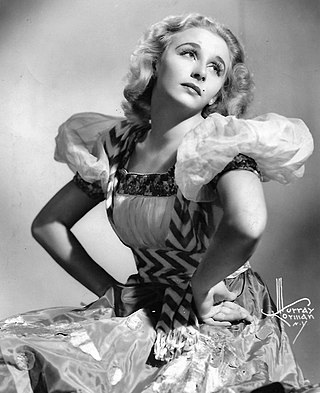
Vera Ralston was a Czech figure skater and actress. She later became a naturalized American citizen. She worked as an actress during the 1940s and 1950s.

Leave 'Em Laughing is a 1928 two-reel silent film starring Stan Laurel and Oliver Hardy. Produced by the Hal Roach Studios, it was shot in October 1927 and released January 28, 1928 by Metro-Goldwyn-Mayer.
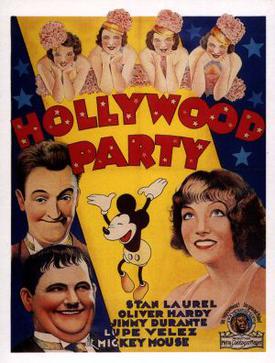
Hollywood Party, also known under its working title of The Hollywood Revue of 1933 and Star Spangled Banquet, is a 1934 American pre-Code musical film starring Laurel and Hardy, The Three Stooges, Jimmy Durante, Lupe Vélez and Mickey Mouse. It was distributed by Metro-Goldwyn-Mayer. Each sequence featured a different star with a separate scriptwriter and director assigned.

Allegheny Uprising is a 1939 American Adventure Western film directed by William A. Seiter and starring Claire Trevor and John Wayne. Based on the 1937 novel The First Rebel by Neil H. Swanson, with a screenplay by the film's producer, P. J. Wolfson, the film is loosely based on the historical event known as the Black Boys Rebellion, which took place in 1765 after the conclusion of the French and Indian War. It was produced by RKO Pictures.
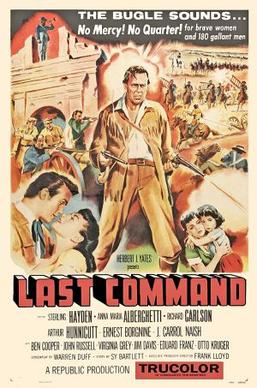
The Last Command is a 1955 American Western film directed by Frank Lloyd starring Sterling Hayden, Anna Maria Alberghetti, Richard Carlson, Arthur Hunnicutt, Ernest Borgnine and J. Carrol Naish based on the life of Jim Bowie and the Battle of the Alamo.
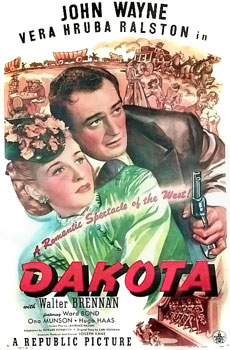
Dakota is a 1945 American Western film directed by Joseph Kane, and starring John Wayne. The supporting cast features Walter Brennan, Ward Bond, and Mike Mazurki.

Outwitting Dad is a lost 1914 American silent comedy film produced by the Lubin Manufacturing Company and featuring Billy Bowers, Raymond McKee, and Oliver Hardy in his first known screen appearance.

For Two Pins is a lost 1914 American silent comedy film produced by the Lubin Manufacturing Company and starring Jimmy Hodges, Marguerite Ne Moyer, and Raymond McKee. Also among the cast was Oliver Hardy, who had a small role as a policeman.
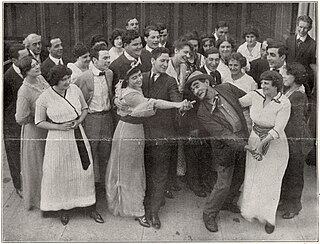
A Tango Tragedy is a lost 1914 American silent comedy film produced by the Lubin Manufacturing Company and starring Billy Bowers, Frances Ne Moyer, and James Hodges. Also among the cast was Oliver Hardy, who had a small role as a man at the dance.

A Brewerytown Romance is a lost 1914 American silent comedy film produced by the Lubin Manufacturing Company, starring Eva Bell, Raymond McKee, Frank Griffin, and Oliver Hardy.

The Female Cop is a lost 1914 American silent comedy film produced by the Lubin Manufacturing Company and starring Mae Hotely and Julia Calhoun, with Oliver Hardy as a "boob cop".

Charles Hugh Roberson was an American actor and stuntman.
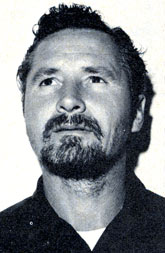
Charles Bert Hayward was an American motion picture stuntman and actor. He was associated particularly with the films of John Wayne. He doubled for most of the great Western and action stars of the 1950s-1980s.
Should Tall Men Marry? is a 1928 American short silent comedy film featuring Stan Laurel. It was his final solo film before he took up his celebrated partnership with Oliver Hardy permanently.




















